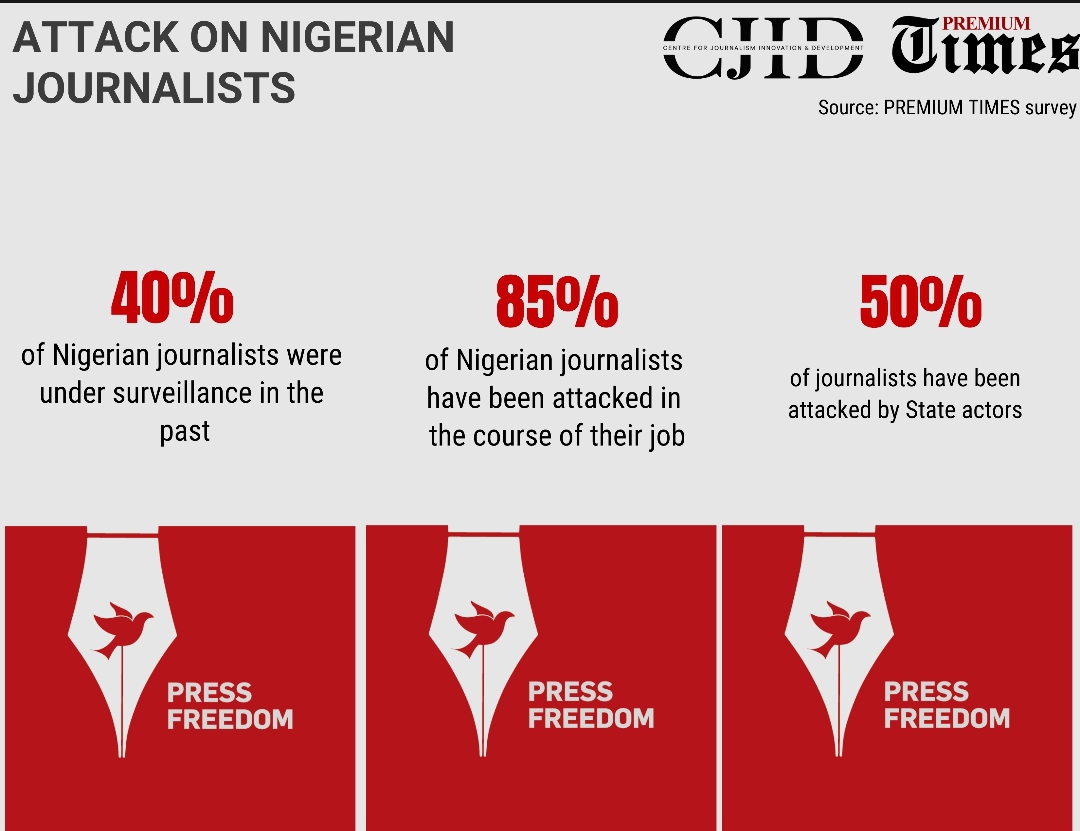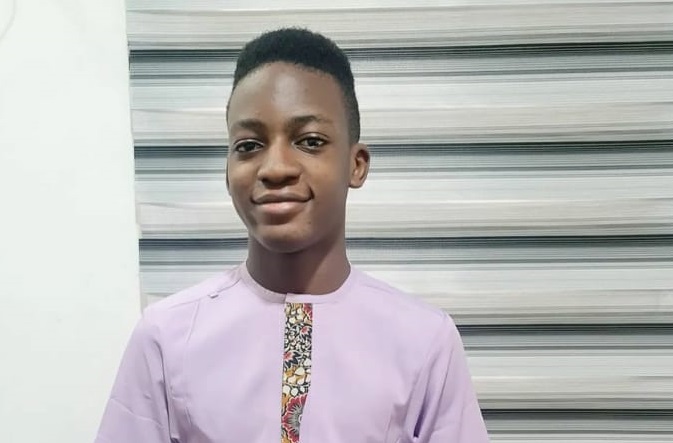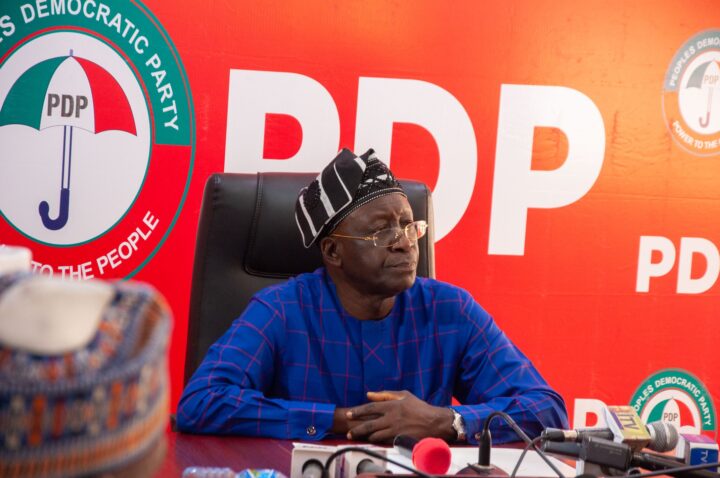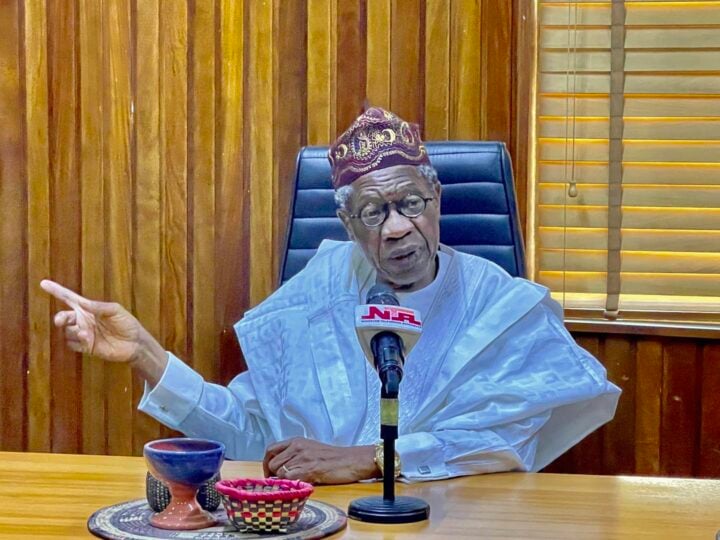BY KABIR YUSUF
Newsrooms are tightening their digital security measures out of concerns that new spy technologies have exposed journalists to even greater threats of surveillance and harassment.
As PREMIUM TIMES’ reporters in 2018, Samuel Ogundipe and Azeezat Adedigba, spoke often over the phone. They had no idea that their regular conversations about work and their personal lives were creating a record accessible for use by the Nigerian state.
On a partly cloudy Saturday in August 2018, Ms Adedigba received a call from a police superintendent that essentially ruined her weekend. The officer, identified as Emmanuel Onyeneho, told Ms Adedigba she was being investigated for criminal offences. The reporter quickly alerted the PREMIUM TIMES management to the development.
Advertisement
Ms Adedigba, then 27, demanded a formal invitation, written on police letterhead, from Onyeneho. The invitation was delivered on 13 August, 2018. In the letter, police alleged criminal conspiracy, cyber crime, attempted kidnapping and fraud against Ms Adedigba and ordered her to turn herself to the force headquarters on 14 August that year.
When she honoured the police invitation, a fully armed police officer forcefully confiscated Ms Adedigba’s telephone. She was then detained for four hours, a distressing experience, she said, that left her with psychological torture to deal with.
Soon, security operatives would order Ms Adedigba to call Ogundipe who was later arrested for refusing to disclose the source of his story that revealed communication between a former Inspector-General of Police, Ibrahim Idris, and then Acting President Yemi Osinbajo. Ogundipe was released on bail.
Advertisement
Nigerian journalists are increasingly under threat from digital and physical surveillance.

The gestapo manner in which the police arrested Ms Adedigba and Ogundipe is part of a growing trend of telecom surveillance used by security agents to lure and then arrest journalists. In the case of Ms Adedigba and Ogundipe, the police made no secret they used call records to establish that the duo had a relationship.
The police methods reinforce the value of internet-based, encrypted communications at a time when authorities have also targeted journalists’ phones and computers to reveal their sources. Newsrooms are tightening their digital security measures out of concerns that new spy technologies have exposed journalists to even greater threats of surveillance and harassment.
Advertisement
“You need basic security tools just to make sure you don’t get hacked — in life, because it really is now your responsibility as a journalist to have good digital hygiene,” says Kano-based journalist, Aliyu Muhammad, who also works as a cybersecurity expert. “Surveillance is already pervasive and now certain kinds of surveillance are being legitimised and legalised.
“And we’re also spending a lot more time online, which means some of the reporting we used to do face to face, we’re doing it digitally, whether through Zoom, which is not end-to-end encrypted, and even just phone calls with sources.”
Muhammad added that journalists need to adopt safety and security measures such as not opening attachments and links on emails and texts from strangers to prevent malware attacks as well as using strong passwords.
“We should always use VPNs and two-factor authentication on our online accounts and above all we need to maintain privacy, especially on social media, and not share personal information carelessly online,” he said.
Advertisement
Last November, Tom Kidwell, a British Army and UK Government intelligence specialist and founder of Ecliptic Dynamics, gave solutions on persistent cyber threat and surveillance.
Kidwell said: “The best way for journalists and media organisations to be proactive in protecting themselves is to implement basic access control and device management. It’s not necessarily the most technical or high-end aspect of cyber, but implementing good procedures and processes makes you a much harder target to exploit.”
Advertisement
The rapid expansion of the digital surveillance industry has enabled governments around the world to acquire new technologies to monitor journalists, silence independent journalism, and control the flow of information. As of April 2021, the Committee to Protect Journalists (CPJ) had identified 38 cases of spyware targeting journalists, commentators, and their associates.
The University of Toronto’s Citizen Lab suggests the true figure could be over 50. There are reports of spyware targeting journalists working with international media outlets, including Al Jazeera and the New York Times.
Advertisement
On its part, the Nigerian government has continued to increase budgetary allocation to surveillance technology. In 2021, the government allocated N4.8 billion to the National Intelligence Agency (NIA) to procure equipment that will “monitor WhatsApp messages, phone calls, and text messages.”
“More than ever before, journalists are monitored when they are online, and when they are not, they are followed; journalists’ email and social media handles are hacked,” said Lekan Otufodunrin, the executive director of Media Career Development Network.
Advertisement
The confidentiality of sources is central to journalists’ ability to properly investigate stories, and to the protection of individuals and whistleblowers who provide information to them, he said.
![]()
“Therefore, efforts to compel the disclosure of sources have a chilling effect on freedom of speech and media freedom,” Otufodunrin added.
Like the case of Ogundipe and Ms Adedigba, police used call records to identify individuals that could be used to lead them to their targets.
In December 2021, investigative journalist Fisayo Soyombo was grilled at the police headquarters in Abuja after his platform published a story on fake police camp projects. Soyombo said the police extracted the phone numbers of everyone connected to the Foundation for Investigative Journalism (FIJ) — including reporters, lawyer and board members —- texting them to appear at the force headquarters.
“If I had not honoured their invitation, they would have tracked our lines to arrest one of us. I do know from the experience that if the authorities are interested in you, they will track your phone and get you to your location. They have the equipment, it is just a question of how high you are on their priority list,” Soyombo said at the time.
A former staffer of the FIJ, Ibrahim Adeyemi, said he received threatening phone messages from the police at the time.
Before Soyombo’s incident, two journalists – Gidado Yushau and Alfred Olufemi– were charged in November 2019 with criminal conspiracy and criminal defamation in connection with a complaint over a May 2018 article Olufemi wrote. The police used a mutual contact to track Yushau and Olufemi who are still facing trial in a court in the north-central Kwara state.
Surveillance activities carried out against journalists run the risk of fundamentally undermining the source protection to which journalists are entitled. Principle 9 of the Global Principles on the Protection of Freedom of Expression and Privacy provides the protection of sources.
However, while the right to privacy is also a fundamental human right enshrined in Nigeria’s constitution, the 1962 Official Secrets Act empowers security forces to grant themselves warrants to search and seize all materials considered evidence, as well as arrest those suspected of committing offences under the act.
In 2019, the Committee to Protect Journalists accused the Nigerian military of using surveillance technology to spy on ordinary Nigerians and the press. The CPJ stated this in a report titled “Nigerian military targeted journalists’ phones, computers with forensic search for source.”
According to the report, the Nigerian military procured a forensic technology designed to extract information from phones and computers. The report stated that two companies – Israel-based Cellebrite and US-based Access Data – that produce and market such technologies used by security forces to monitor and interrogate journalists, were already operating in Nigeria. Between 2014 and 2017, CPJ added that the Nigerian government has spent at least N127 billion ($350 million) on surveillance and security equipment.
Experts believe when the devices of journalists and their sources are vulnerable to surveillance, the ability of journalists to carry out their newsgathering function is significantly diminished.
“Journalists who fear they are a target of surveillance may self-censor. Credible sources may be less likely to talk to the press, and media outlets may struggle financially to keep pace with the increasingly sophisticated threats facing their staff,” Otufodunrin of media career development said.
Nigeria has 214 million active mobile phone lines, with roughly two million lines added every month, according to 2022 data released by the national telecom regulator, the Nigerian Communications Commission (NCC). SIM card ownership for these lines is tracked under a 2011 regulation that mandates the collection of personal information, including fingerprints and photos, that police can access without a warrant as long as a senior-ranking security officer gives written approval. Other NCC regulations, released in October 2019, detail police permissions to intercept communications under certain circumstances.
The police also use this instrument to harass critics.

Recently, police officers attached to Nigeria’s first lady, Aisha Buhari, tracked Aminu Adamu, a Nigerian student, through his phone. He was arrested and detained on the orders of Buhari in late 2022.
This abusive use of surveillance equipment to target critics, journalists, their associates, and their families adds to the numerous and growing risks that journalists worldwide now face.
In Nigeria, it’s an addition to physical attacks and harassment journalists face.
The Press Attack Tracker, a platform that tracks attacks on journalists in Nigeria, reported that at least 179 cases of attacks on journalists were recorded in the last four years. State actors account for half of the attacks, while non-state actors account for 36.4 per cent and unknown persons for 13.6 per cent.
A PREMIUM TIMES’ survey – part of reporting for this article – also shows that journalists (and their collaborators like fixers) have become increasingly vulnerable to attacks from state and non-state actors that compromise their security, threaten source confidentiality, and ultimately undermine journalism.
At least 40 per cent of journalists polled in the survey said they were under surveillance in the past, while 85 per cent said they had been attacked in the course of their job.
The report is supported by the Centre for Journalism Innovation and Development (CJID) in partnership with the Justice for Journalists Foundation.
Add a comment






